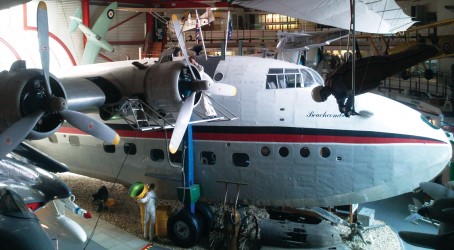Museums
It’s doubtful that anyone who is prone to judging a book by its cover will have paid a visit to Southampton’s Solent Sky Museum. This collection of aviation memorabilia is housed within one of the most hideous buildings imaginable – a corrugated metal construct, located in a shabby part of town, with no clear signage to entice passers-by. It’s amazing the place gets any visitors at all.
That’s a shame because if you can get past first impressions, Solent Sky will reward you with a wonderful array of aircraft along with a laidback atmosphere so often missing in places of historical interest. It is also blessed with well-informed attendants.
The centrepiece of the museum is a gigantic Short Sandringham VH-BRC Beachcomber, the only commercial four-engined flying-boat on show in the UK. The aircraft was built in the 1940s by Short Brothers in Rochester, Kent as a standard Sunderland Mk III general reconnaissance flying boat and was later converted to carry passengers on the 1,300-mile route between Sydney and Auckland.
Southampton was the only marine airport in the UK that operated large passenger-carrying flying boats, hence the Beachcomber’s prominent display in the collection.
Visitors are encouraged to clamber aboard this leviathan of the skies and to do so is to be transported back in time. Passengers sat four-by-four facing each other in compartments reminiscent of old-style railway carriages. There’s a 1940s feel to the interior, with mock-wooden wall panels dotted with black and white photographs illuminated by ornate light fittings. If you sit down in one of the comfy seats and shut your eyes, it’s easy to imagine the massive turboprops propelling you across the sea.

A few yards away from the Beachcomber is a fine example of a Vickers-Supermarine Spitfire Mk 24, one of the last of its type. It appeared in 1946 as a long-range fighter-bomber development of the Mk 22 from which it differed in having a 24-volt electrical system, rear fuselage fuel tanks, and provision for under-wing rockets. PK683, on show at Solent Sky, saw service with the RAF in Malaysia and is in almost original condition.
There are 28 aircraft on show, ranging from the earliest gliders to Cold War jetfighters. There are also plenty of associated components to take a look at, including a Napier Naiad, the world’s first axial flow turboprop engine. The Naiad produced 1,600hp with a 12-stage compressor and two-stage turbine. An unusual feature of the engine was the hollow ducted spinner with its annular air intake.
By the time you’ve looked at all the displays, the horrors of Solent Sky’s drab exterior are forgotten. But the rundown façade does tell a story of its own – the museum relies purely on visitor attendance and donations to keep it going and as costs rise, this is becoming harder to achieve. Every person through the door helps secure its future.